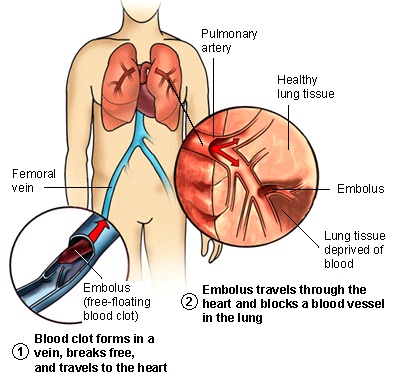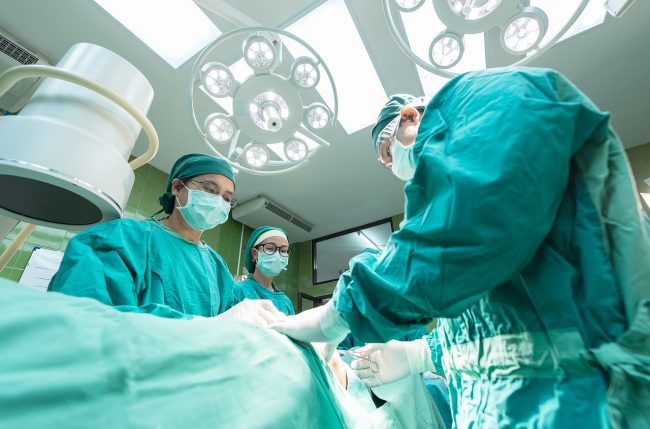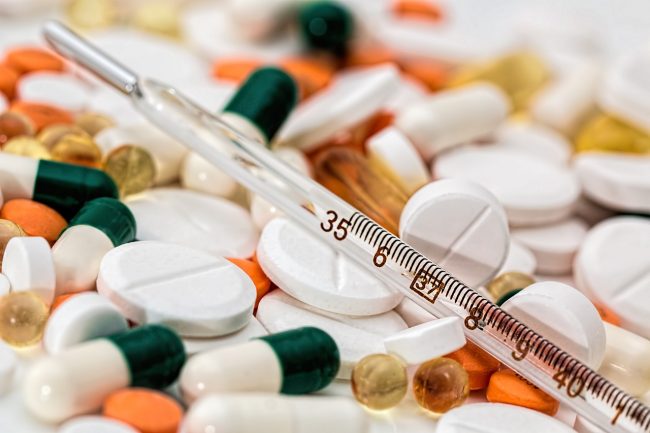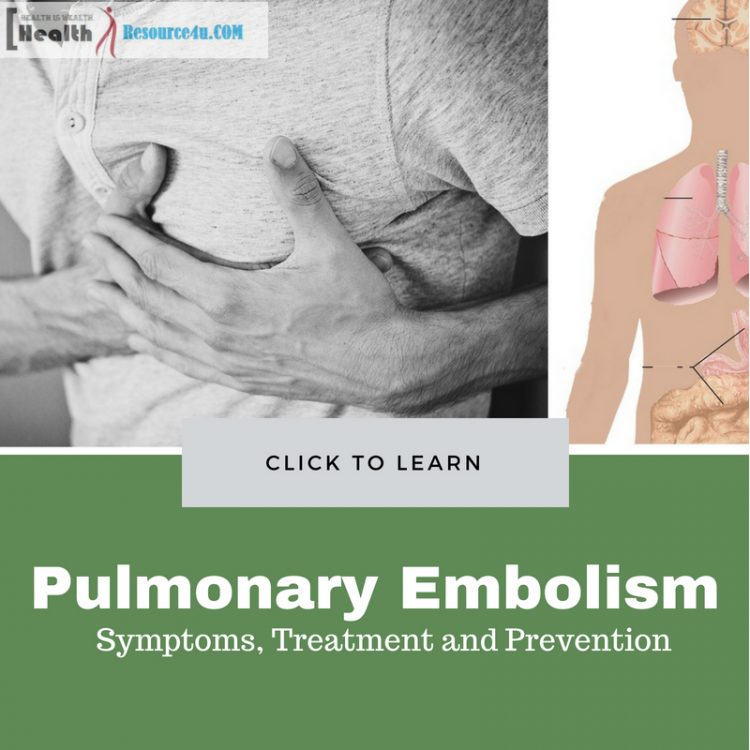Shortness or difficulty in breathing due to the blood clot in the arteries carrying blood to the lungs develops the Pulmonary Embolism (PE) disease condition. This can be fatal and life-threatening too if immediate treatment is not started for removing the blood clots existing in the veins. Symptoms of pulmonary embolism vary depending upon the different factors however with instant treatment it can be relieved completely.
The blockage in the pulmonary arteries causes difficulty in breathing, chest pain and other discomforts to the affected person. Mostly the blood clots in the vessels which run through legs to lungs cause to pulmonary embolism which can lead to death also if it gets fatal. The blood clot in the deep veins of legs is called Deep Vein Thrombosis (DVT).
Causes of Pulmonary Embolism
Table of Contents

Usually, the Pulmonary Embolism occurs due to clots in the deep vein such as in legs and arms and these clots slowly create blockage when it passes through the shrink or small vessels towards lungs henceforth the flow of blood towards lungs get disrupted resulting in chest pain and breathing shortness.
In the lack of proper oxygen in the lungs, the patient can even collapse so it requires immediate medical attention for saving the life of the affected person. Some other reasons are also which can develop to this health condition. The overall causes PE disease is enlisted below.
Fracture or Injury
Some kind of injury or accident causes fractures in bones, tears in muscle etc. This kind of injury damages the deep blood vessels leading to clots which later on create difficulty in normal blood flow towards lungs hence Pulmonary Embolism develops.
Immobility
If any part of the body remains inactive or immobile for a very long period of time due to any reason then the blood of this particular area get stagnate in the lowest part or vessels of the body leading to clot development. This kind of immobility develops during a long journey when you sit at a particular place, some kind of illness in which bed rest is required by the patient etc.
Special Medical Condition
Some special medical condition in which blood clots formed very easily can cause to the development of Pulmonary Embolism health condition. These health conditions include heart disease, chemotherapy treatment for curing the cancer patient, any surgery etc.
Symptoms of Pulmonary Embolism

- Breathing shortness or difficulty in normal breathing arises quite often and worsens the condition of a patient with the deep breath or chest pain.
- A frequent cough is observed which is accompanied by bloody sputum or spit.
- Severe cramp in chest occurs which gives the feeling of the heart attack. The chest pain gets worsen while eating, coughing, bending, deep breathing, exertion. Even with rest, this pain can’t be relieved.
- Pain or swelling in the leg mainly in the calf.
- Excess sweating or more than usual sweat occurs.
- Feeling of dizziness or lightheadedness.
- Heart rate gets faster.
- Anxiety and restlessness.
- Skin discoloration or blue lips and nails.
- Fever
- Back pain
- Very weak pulse rate.
Anyone noticing any of these above-mentioned symptoms especially shortness of breath should without making any further delay needs immediate medical attention otherwise the condition may get worse and out of control.
Treatment of Pulmonary Embolism
The Pulmonary Embolism is a major health condition which symptoms are quite painful and keep the affected person restless all the time. So it needed immediate medical treatment for relieving the condition of patient immediately otherwise its complications may increase which can cause to death of the patient.
The treatment process of this disease depends primarily on the size of the blood clot and its location in the body of the patient. In the initial stage when the size of blood clots remain small then it can be treated through medications only. These medicines help to dissolve these clots so that normal blood flow can be started and the patient can get back to his or her normal health condition.
Some general medications which are prescribed for treating this disease by the doctors are following:
Anticoagulants:
The anticoagulants medications are also known as blood thinners which help to thin the layer of blood so that the clotting which is already formed in your blood can be dissolved easily. Warfarin and Heparin are some most common blood thinners which prevents the formation of new blood clots. This medication proves as a life savior under an emergency situation.
Warfarin is an oral tablet whereas Heparin is a liquid medication which is given through the injection in the hospital. The Low molecular-weight heparin is injected beneath or under the skin of the patient. This can be taken at home also. As per the requirement, it can be given either once or twice in a day.
Fondaparinux (Arixtra) is a newly invented medication which is mostly injected once in a day. If anticoagulant is prescribed by the doctor to be taken in the home then either patient or their family member should properly understand regarding its doses and timing as any small mistake in this regards may call big health trouble to you and your condition can be worsened or out of control.
Compression Stockings:
The Compression Stockings supports blood flow in the legs. The length of stockings is generally up to the knee which compresses your legs for preventing blood pooling. This should only be used if prescribed by the doctor.
Clot Dissolvers (Thrombolytics):
The clot dissolver medicines faster the dissolving process of blood clots. These medications are only prescribed under the emergency situation for the immediate effect as these medicines carry risky side effects such as heavy bleeding.
The clot dissolvers are primarily given in the hospitals only so that close monitoring of the patient’s condition can be done. Only if the patient condition is unstable or blood pressure is low then only these medications are applied.
Surgery Process

Following surgery process are generally conducted for treating the pulmonary embolism health condition.
Clot Removal
In the clot removal surgery process a thin tube known as catheter is inserted in the veins for suctioning the big clots from arteries. This is a less preferred surgery process because it involves difficulties so it is not considered in the first priority.
Vein Filter
In the vein filter surgery treatment one small incision is made by the doctor to install a filter of very small size in the inferior vena cava with the help of thin wire. The vena cava is the primary vein which passes through your legs to the right side of heart. This vein filter obstructs the travelling of blood clots from the legs to the lungs of the patient.
Open Surgery
Open surgery is the last and final option in the hands of doctors which is only applied in very emergency condition like the patient is in shock or the prescribed medications for dissolving blood clots are not working effectively.
Natural Measures for Preventing Pulmonary Embolism
The Pulmonary Embolism is a very severe health condition which causes blockage in lungs resulting in breathing shortness and other chronic health issues. This health condition can be raised due to many reasons which needed immediate medical help otherwise it can cause death to the affected person due to irregularity in breathing.
No one can survive with this kind of disease normally so it is important for everyone to use and apply some natural preventive measures for avoiding the Pulmonary Embolism disease.
Maintain Your Body Weight

Take Care of Your Diet
A healthy life style can prevent many serious health hazards in this regard your regular diet also plays a vital role for ensuring a healthy life and free of chronic diseases such as pulmonary embolism. There are some foods which elevate the risk of blood clot in the different parts of your body. So for preventing the risk of PE you should avoid unhealthy diets and include healthy and necessary diets in your day to day life.
Foods which have anti-coagulant and anti-inflammatory properties reduce the risk of PE. These foods include herbs, spices, raw honey, fish oil, omega 3 fatty acid, green tea, apple cider vinegar, dark chocolates, beans, nuts, seeds, Vitamin E and Vitamin D containing veggies and fruits.
Always be Active
A sedentary lifestyle or inactive living habit causes to the development of blood clots which can take the form of pulmonary embolism if not treated in its very initial stage. So preventing the risk of such a life threatening disease always stay active in your life.
Some especial conditions like after surgery, during pregnancy, obesity etc. people remains inactive for a very longer period and take bed rest which contributes to the blood pooling. For avoiding the PE symptoms keep your body mobilized in every situation, move your body parts frequently and walk everyday as because the long time rest causes the development of DVT.
Do exercise everyday as it will keep your blood flow in the normal level and prevents the risk of PE or DVT. Aerobic exercises are considered as the best one for preventing the risk of pulmonary embolism. These exercises include HIIT workout, cycling, running etc. If you have crossed your age 40 or your age is above 50 then regular exercise is most important for you as higher age people are most likely at risk to develop the PE health condition.
Maintain Precautions after Injury or Trauma Surgery and Hospitalization
As per the medical study and experiences, it is found that the blood clots development risk remains high after an injury, surgery, trauma, and stress. So if you have met through any small or serious fracture, surgery and injury then maintain especial precaution otherwise your careless behavior during this point of time lead the development of DVT.
Stress or any traumatic event of life plays a very vital role in casing PE. Stress affects your normal blood circulation level which gradually causes to development of blood clots. Several surveys have proved that mostly the pulmonary embolism cases generates in the hospital only as because the patient remains immobilized or inactive for the couple of days which affects to his or her blood flow functioning leading to generate DVT process.
So if you have recently released from the hospital after treatment then make sure that your body does not remain inactive for long hours. Keep yourself active; engage in some small works so that your body won’t get any reason to develop clots. This way you can prevent the risk of pulmonary embolism.
Consider Your Medications

If you are taking any of these pills and noticing any symptom of pulmonary embolism then immediately consult with your doctor and ask for giving alternate medicines or you can also try any natural measure to relieve your these health conditions.
Once the treatment is completed in the hospital the patient is discharged and given necessary instruction for care and protection of health in the home. The patient needs to follow the recommendation and suggestion by the doctors for preventing future blood clots and symptoms of pulmonary embolism.

